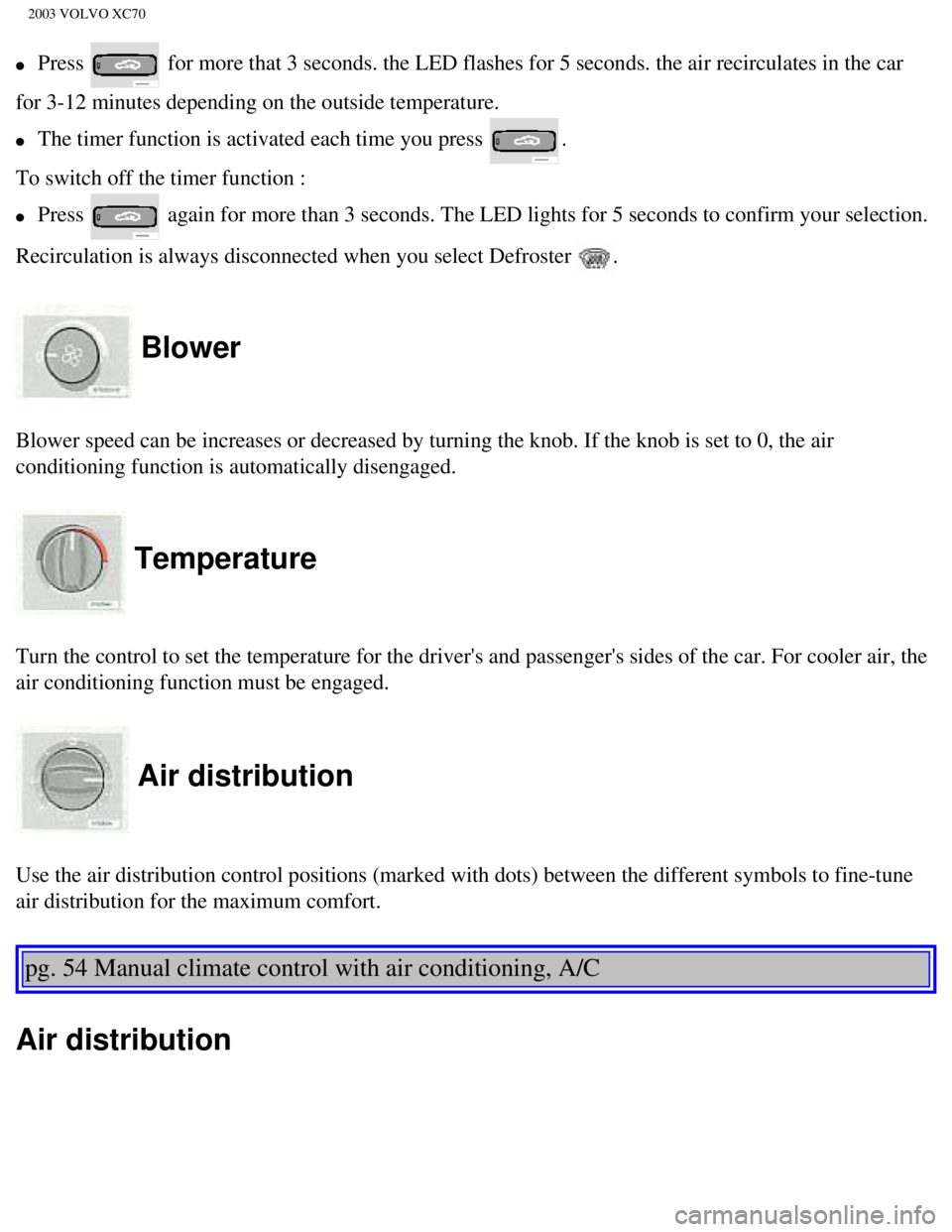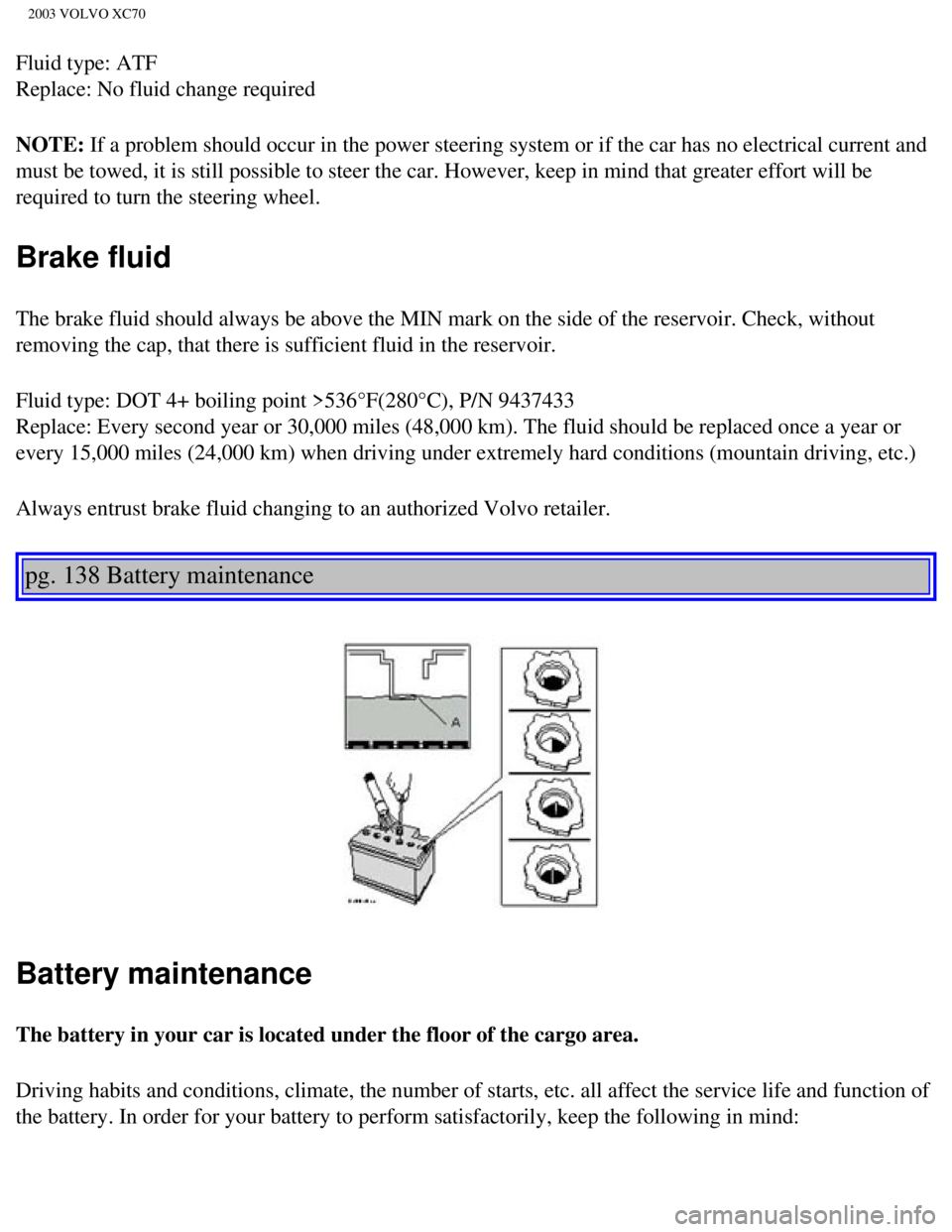2003 VOLVO XC70 Climat
[x] Cancel search: ClimatPage 77 of 257

2003 VOLVO XC70
1. Press : the LED AUT comes on. The Air quality sensor is now activated.
2. Press
: no LED is lighted. Recirculation not activated.
3. Press
: the LED MAN comes on. Recirculation is now activated.
You can switch between these three functions by repeatedly pressing
Keep the following in mind:
l Make it a rule to have the Air quality sensor activated at all times.
l Recirculation is limited in cold climates to avoid misting up.
l If misting occurs, you should deactivate the Air quality sensor.
l If the windows mist up, you can also use the windshield and side window \
defroster functions. See
page 49.
l The filter should be changed at the intervals listed in the Warranty and\
Service Records Information
booklet. However, if the car is used in a severely contaminated environm\
ent, it may be necessary to
change the filter more frequently.
pg. 52 Manual climate control with air conditioning, A/C
pg. 53 Manual climate control with air conditioning, A/C
file:///K|/ownersdocs/2003/2003_XC70/03xc70_03.htm (9 of 12)12/30/2006\
4:17:55 PM
Page 79 of 257

2003 VOLVO XC70
l Press for more that 3 seconds. the LED flashes for 5 seconds. the air recircu\
lates in the car
for 3-12 minutes depending on the outside temperature.
l The timer function is activated each time you press .
To switch off the timer function :
l Press again for more than 3 seconds. The LED lights for 5 seconds to confirm \
your selection.
Recirculation is always disconnected when you select Defroster
.
Blower
Blower speed can be increases or decreased by turning the knob. If the k\
nob is set to 0, the air
conditioning function is automatically disengaged.
Temperature
Turn the control to set the temperature for the driver's and passenger's\
sides of the car. For cooler air, the
air conditioning function must be engaged.
Air distribution
Use the air distribution control positions (marked with dots) between \
the different symbols to fine-tune
air distribution for the maximum comfort.
pg. 54 Manual climate control with air conditioning, A/C
Air distribution
file:///K|/ownersdocs/2003/2003_XC70/03xc70_03.htm (11 of 12)12/30/200\
6 4:17:55 PM
Page 149 of 257

2003 VOLVO XC70
pg. 101 Towing a trailer
When preparing for trailer towing, observe the following:
Volvo recommends the use of Volvo trailer hitches which are specially de\
signed for the car.
l Maximum trailer weight recommended by Volvo is:
Trailers without brakes: 1100 lbs (500 kg)
Trailers with brakes: 3300 lbs* (1,500 kg),
Observe the legal requirements of the state/province in which the vehicl\
es are registered.
l All Volvo models are equipped with energy-absorbing shock-mounted bumper\
s. Trailer hitch
installation should not interfere with the proper operation of this bump\
er system.
Trailer towing does not normally present any particular problems, but ta\
ke into consideration:
l Increase tire pressure to recommended full. See section "Wheels and tire\
s".
l When your car is new, avoid towing heavy trailers during the first 620 m\
iles (1000 km).
l Recommended hitch tongue load is:
Trailer weights below 2,650 lbs (1,200 kg) - 110 lbs (50 kg)
Trailer weights above 2,650 lbs (1,200 kg) - 165 lbs (75 kg)
l Maximum speed when towing a trailer: 50 mph (80 km/h).
l Engine and transmission are subject to increased loads. Therefore, engin\
e coolant temperature should
be closely watched when driving in hot climates or hilly terrain. Use a \
lower gear and turn off the air
conditioner if the temperature gauge needle enters the red range.
l If the automatic transmission begins to overheat, a message will be disp\
layed in the text window.
l Avoid overload and other abusive operation.
l Hauling a trailer affects handling, durability, and economy.
l It is necessary to balance trailer brakes with the towing vehicle brakes\
to provide a safe stop (check
and observe state/local regulations).
l Do not connect the trailer's brake system directly to the vehicle's brak\
e system.
l More frequent vehicle maintenance is required.
l Remove the ball and drawbar assembly when the hitch is not being used.
l Volvo recommends the use of synthetic engine oil when towing a trailer o\
ver long distances or in
mountainous areas.
file:///K|/ownersdocs/2003/2003_XC70/03xc70_06b.htm (4 of 10)12/30/200\
6 4:18:00 PM
Page 161 of 257

2003 VOLVO XC70
Uniform tire quality grading
ALL PASSENGER CAR TIRES MUST CONFORM TO FEDERAL SAFETY REQUIREMENTS
IN ADDITION TO THESE GRADES
Quality grades can be found, where applicable, on the tire sidewall betw\
een the tread shoulder and
maximum section width. For example:
Treadwear 200 Traction AA Temperature A
TREADWEAR
The treadwear grade is a comparative rating based on the wear rate of th\
e tire when tested under
controlled conditions on a specified government test course. For example\
, a tire graded 150 would wear
one and one half (1 1/2) times as well on the government course as a t\
ire graded 100. The relative
performance of tires depends upon the actual conditions of their use, ho\
wever, and many depart
significantly from the norm due to variation in driving habits, service \
practices and differences in road
characteristics and climate.
TRACTION
The traction grades, from highest to lowest, are AA, A, B, and C, as mea\
sured under controlled
conditions on specified government test surfaces of asphalt and concrete\
. A tire marked C may have
poor traction performance. WARNING!
The traction grade assigned to this tire is based on braking (straight-\
ahead) traction tests and is not a
measure of cornering (turning) traction.
TEMPERATURE
The temperature grades are AA (the highest), A, B, and C, representing\
the tire's resistance to the
generation of heat and its ability to dissipate heat when tested under c\
ontrolled conditions on a specified
indoor laboratory test wheel. Sustained high temperature can cause the m\
aterial of the tire to degenerate
and reduce tire life, and excessive temperature can lead to sudden tire \
failure. The grade C corresponds
to a minimum level of performance which all passenger car tires must mee\
t under the Federal Motor
Safety Standard No. 109. Grades B and A represent higher levels of perfo\
rmance on the laboratory test
wheel than the minimum required by law.
file:///K|/ownersdocs/2003/2003_XC70/03xc70_07.htm (6 of 10)12/30/2006\
4:18:01 PM
Page 170 of 257

2003 VOLVO XC70
Location Amperage
1 Low beam headlights 15A
2 High beam headlights 20A
3 Power driver's seat 30A
4 Power passenger's seat 30A
5 -
6 -
7 Heated seat - front left (option) 15A
8 Heated seat - front right (option) 15A
9 ABS/STC/DSTC 5A
10 -
11 -
12 Headlight wipers (certain models) 15A
13 Electric socket 12 V 15A
14 Power passenger's seat 5A
15 Audio system, VNS 5A
16 Audio system 20A
17 Audio amplifier 30A
18 Front fog lights 15A
19 VNS display 10A
20 -
21 Automatic transmission, shiftlock, extended D2 feed 10A
22 Direction indicators 20A
23 Headlight switch module, climate control system, onboard diagnostic c\
onnector, steering
wheel lever modules 5A
file:///K|/ownersdocs/2003/2003_XC70/03xc70_08a.htm (5 of 21)12/30/200\
6 4:18:03 PM
Page 171 of 257

2003 VOLVO XC70
24 Relay for extended D1 feed: climate control system, power driver's se\
at, driver's info 10A
25 Ignition switch, relay starter motor, SRS, engine control module 10A
26 Climate control system blower 30A
27 -
28 Electronic module - courtesy lighting 10A
29 -
30 Left front/rear parking lights 7.5A
31 Right front/rear parking lights, license plate lights 7.5A
32 Central electrical module, vanity mirror lighting, power steering, gl\
ove compartment
light, interior courtesy lighting 10A
33 Fuel pump 15A
34 Power sun roof 15A
35 Central locking system, power windows - left door mirror 25A
36 Central locking system, power windows - right door mirror 25A
37 Rear power windows, power child safety 30A
38 Alarm siren 5A
* Please be aware that if this fuse is not intact, or if it is removed, \
the alarm will sound.
pg. 119 Fuses in the cargo area
Fuses in the cargo area
The fuses in the cargo area are located on the trim on the left-hand sid\
e. When replacing a blown fuse,
be sure to replace it with a new one of the same color and amperage (wr\
itten on the fuse).
file:///K|/ownersdocs/2003/2003_XC70/03xc70_08a.htm (6 of 21)12/30/200\
6 4:18:03 PM
Page 194 of 257

2003 VOLVO XC70
Volvo Cars recommends Castrol.
Depending on your driving habits, premium or synthetic oils may provide \
superior fuel economy and
engine protection. Consult your Volvo retailer for recommendations on pr\
emium or synthetic oils.
Oil additives must not be used.
NOTE: Synthetic oil is not used when the oil is changed at the normal maintena\
nce services. This oil is
only used at customer request, at additional charge. Please consult your\
Volvo retailer.
Oil viscosity (stable ambient temperatures)
Operation in temperate climates
Incorrect viscosity oil can shorten engine life. Under normal use when t\
emperatures do not exceed 86 °F
(30°C), SAE 5W/30 will provide good fuel economy and engine protect\
ion. See the viscosity chart
below.
Operation in hot climates
When temperatures exceed 86 °F (30°C) in your area, Volvo recomm\
ends, for the protection of your
engine, that you use a heavier weight oil, such as SAE 10W/30. See the v\
iscosity chart below.
Extreme engine operation
Synthetic oils meeting SAE 10W/30 and complying with oil quality require\
ments are recommended for
driving in areas of sustained temperature extremes (hot or cold), when\
towing a trailer over long
distances, and for prolonged driving in mountainous areas.
Changing oil and oil filter
Oil and oil filter changes should be made at 7,500 mile (12,000 km) in\
tervals.
The API Service Symbol
The API Service Symbol "donut" is divided into three parts:
file:///K|/ownersdocs/2003/2003_XC70/03xc70_08b.htm (8 of 16)12/30/200\
6 4:18:04 PM
Page 197 of 257

2003 VOLVO XC70
Fluid type: ATF
Replace: No fluid change required
NOTE: If a problem should occur in the power steering system or if the car ha\
s no electrical current and
must be towed, it is still possible to steer the car. However, keep in m\
ind that greater effort will be
required to turn the steering wheel.
Brake fluid
The brake fluid should always be above the MIN mark on the side of the r\
eservoir. Check, without
removing the cap, that there is sufficient fluid in the reservoir.
Fluid type: DOT 4+ boiling point >536°F(280°C), P/N 9437433
Replace: Every second year or 30,000 miles (48,000 km). The fluid shou\
ld be replaced once a year or
every 15,000 miles (24,000 km) when driving under extremely hard condi\
tions (mountain driving, etc.)
Always entrust brake fluid changing to an authorized Volvo retailer.
pg. 138 Battery maintenance
Battery maintenance
The battery in your car is located under the floor of the cargo area.
Driving habits and conditions, climate, the number of starts, etc. all a\
ffect the service life and function of
the battery. In order for your battery to perform satisfactorily, keep t\
he following in mind:
file:///K|/ownersdocs/2003/2003_XC70/03xc70_08b.htm (11 of 16)12/30/20\
06 4:18:04 PM